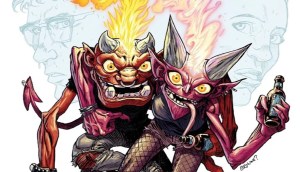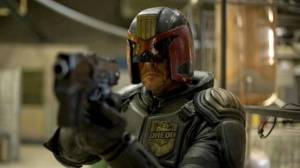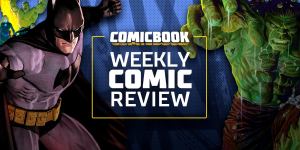
Hellboy in Hell #10 was released this month marking the official ending of Mike Mignola’s epic comics story of a red-skinned, demonic baby with an enormous stone hand deposited upon Earth to fulfill a mysterious destiny. The finale issue may not show Hellboy answering prophecy, but it certainly realizes the promise of this long running series. From Mignola’s mastery of the comics page to his deft use of tone to the surprisingly subtle interweaving of themes on self-determination and inevitability, Hellboy in Hell #10 delivers a stunning issue. Now Mignola plans on using this moment to step away from comics in order to focus on his art, specifically painting. It is a well-earned rest from an artform that is driven by monthly scheduling.
Videos by ComicBook.com
It may not be clear to everyone reading Hellboy comics or even those simply aware of the character just how great of an accomplishment this finale marks though. For that to be recognized, it’s important to look back on the character’s history.
Hellboy was not born in the isles of Britain during World War II, but the halls of a crowded San Diego Comic Con in 1993, making him older than many new comics readers of today. The original drawing barely resembles the Hellboy comics readers know today, but the name Mignola wrote on the beastly figure’s belt stuck and inspired him to keep drawing. That is what led to the publication of the four-issue miniseries “Seed of Destruction” at Dark Horse Comics almost one year later.
From that first story, which also featured the debut of characters like Abe Sapien, Liz Sherman, and Mignola’s interpretation of the historical figure Rasputin, a new favorite in American comics was born. Mignola continued to expand the history of Hellboy and his companions at the Bureau of Paranormal Research and Defense (BPRD) through a series of one-shots and additional miniseries. Mignola both wrote and drew all of the stories for the first decade of the series. His vision was a singular one, presenting him as one of the most distinctive draftsman and storytellers in comics since Jack Kirby created The Fourth World Saga.
As Hellboy continued to gain a wider readership and Mignola’s pursuits became more varied, others were invited into the Hellboy universe. The 2006 story “Makoma” saw Richard Corben become the first artist to help illustrate one of Mignola’s Hellboy comics besides Mignola himself. After that James Sinclair and Duncan Fegredo would become a central force in the comic.
There were spinoff series as well. The B.P.R.D., Abe Sapien, Lobster Johnson, and Sir Edward Grey have all received a variety of ongoing series, miniseries, and one-shots expanding upon the supporting cast and mythology begun in Hellboy’s adventures. Other comics series featuring Mignola’s creative power and a similar tone, like Baltimore and Joe Golem, have also come to feel like companion pieces. Each of these comics have expanded the number of creators, including writers, artists, colorists, and letterers, working within the Hellboy line of comics.

The expansion of Mignola’s Hellboy is not limited only to comics either. Visionary director Guillermo del Toro directed two live action film adaptations in 2004 and 2008. Actor Ron Perlman captured Hellboy’s bizarre appearance perfectly and portrayed his dry humor perfectly, cementing Hellboy as one of his most iconic roles from decades of performances. Both movies were praised for their unique aesthetic and the faithful manner in which they captured the comic’s characters and tone. There have been multiple cartoon movie adaptations as well distributed direct to DVD.
Almost 25 years after he first appeared in a convention pamphlet, Hellboy is the centerpiece of a major entertainment franchise impacting both comics and film. His stories and the stories of his friends, enemies, and acquaintances can be enjoyed for days on end. While Hellboy’s story may have just ended in Hellboy in Hell #10, the stories of the BPRD and Abe Sapien continue in ongoing comics series and the possibility of a third film is still being discussed. All of this creative power and potential can be traced back to the mind of Mike Mignola.
Therein lies the achievement. In an age where so many comics storytellers are defined by their contributions to what has come before, Mignola created his own legacy of creations. After discovering his own unique style working on excellent series like Cosmic Odyssey at DC Comics and Doctor Strange and Doctor Doom: Triumph and Torment at Marvel Comics, he took those skills to construct characters and an entire universe that were uniquely his.
That act of creation did not just cement Mignola’s status as a master in the world of comics either. Hellboy and his other creations have earned him more awards than one could desire to count. His total number of Eisner Awards could not be counted by a child using both of their hands. This work paid dividends not just to Mignola, but to the creative world at large.
Consider the recognition of Dave Stewart as one of the most significant and skilled colorists working in comics today. It is through Stewart’s work on so many Hellboy comics that many everyday readers began to recognize coloring as a unique art form worthy of recognition.
Consider the many talented creators working with Mignola on his Hellboy comics. Duncan Fegredo and James Sinclair’s stunning work gained a much wider audience while collaborating with Mignola. Others like John Arcudi and James Harren refined their skills in order to pursue their own creations in comics like Rumble.
Consider the films del Toro created with Hellboy as their centerpiece. He utilized the concept of Hellboy to focus his own cinematic style and approach to visual language. In addition to that del Toro’s films employed set designers, decorators, prop technicians, costume designers, and many others who were able to practice their own arts as a result of the production.

By focusing on his own artwork, Mike Mignola told his own story in an inimitable fashion that will be marveled at for years to come. He also managed to provide inspiration and opportunities for other artists across a variety of media. While it is technically possible to count the thousands of creatives who have worked on Hellboy stories, it is impossible to number those pushed towards success simply by coming in contact with them in comics or film.
Hellboy is over. That is okay. Comics doesn’t need more Hellboy; it has Mignola’s completed story now. Comics could use more things like Hellboy though. Original creations from artists like James Harren and Cameron Stewart, both contributors to the Hellboy universe, are what will allow for this story to be written again in another two decades. Their original comics have the potential to inspire new universes, new films, and new generations of creators. While we now look back and enjoy Mignola’s Hellboy stories, we would be well suited to look ahead as well.





